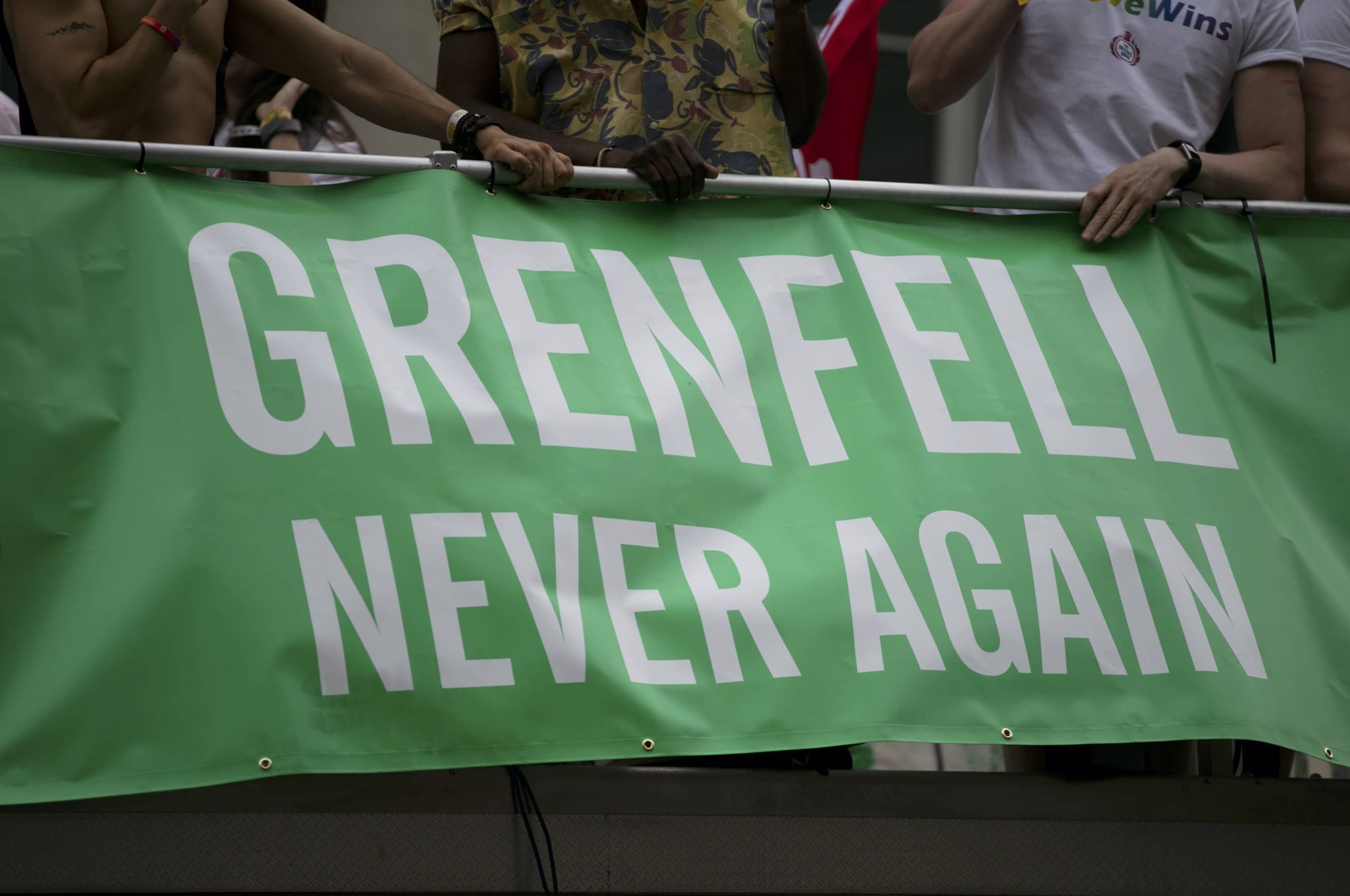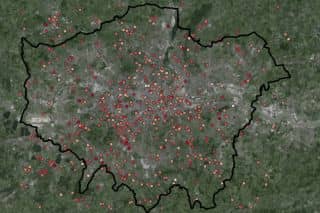
www.buildingsandcities.org/insights/commentaries/research-prioritise-inhabitants.html
Why Research Must Now Prioritise Inhabitants

Challenges ahead: understanding and protecting the end-users of the built environment
The recent flammable cladding crisis has highlighted that inhabitants are not receiving the attention they deserve for better outcomes. Trivess Moore and David Oswald (both at RMIT University) explain why the research community needs to create a research agenda that focuses on the end-users of the built environment: their health, wellbeing, social value and lifestyle needs as well as the avoidance of risks, defects, natural hazards and stranded assets. This will give researchers greater influence on policy, practice and outcomes.
The 2017 Grenfell Tower (London, UK) fire was a catastrophic event with the loss of 72 lives and countless more impacted (Moore-Bick, 2019). The fire spread quickly because of the flammable cladding on the exterior of the building (McKenna et al. 2019; Moore-Bick 2019). This event shook the world, led to a public inquiry in the UK (Moore-Bick, 2019; Moore-Bick et al. 2024) and initiated governments across the world to review buildings that could have flammable cladding (e.g Victorian Cladding Taskforce 2017). It also initiated academic research post-disaster, including lessons from Grenfell (Hayes 2017), investigating the fire behaviour of modern facades (McKenna et al. 2019), and the impacts of the 'cladding scandal' on leaseholders in the UK (Martin & Preece 2021).
Post Grenfell, research findings have revealed just how little protection consumers have to ensure they are provided safe and secure housing (Cook & Taylor 2023; Martin 2021; Martin & Preece 2021; Oswald 2021; Oswald & Moore 2022; Oswald et al. 2022). In many instances, consumers in locations like Australia, who found out they had flammable cladding on their buildings in the months and years after Grenfell, realised that they were not protected by building warranties or from irresponsible companies 'phoenixing' to avoid liability. Phoenixing is the process of a company declaring bankruptcy after transferring assets to a new company. As many building contracts and warranties sit with the original company, this has left thousands of homeowners with little support and facing significant financial costs to make their dwellings safe (Oswald & Moore 2022). Sadly, flammable cladding is yet another example of a defect that had a devasting impact on inhabitants. Asbestos, leaky buildings, non-durable materials (e.g. reinforced autoclaved aerated concrete - RAAC), cracks and collapse, are all examples where the consumer has been failed (Howden-Chapman et al. 2009; Johnston & Reid 2019; Oswald & Moore 2022; Thomas 2023).
These consumer issues will be further exacerbated by climate change, where dwellings in some locations are now deemed unsafe or uninsurable due to increased flood and fire risks (Moore & Doyon 2023). As the climate-crisis unfolds and governments begin to incentivise residents to retrofit their homes for greener alternatives, this consumer protection issue will become more important for convincing inhabitants to undertake construction activities within their homes. For example, there is some emerging research that highlights unintended consequences of retrofit, such as risk of mould from a dwelling being too airtight, which will have implications for consumers health and wellbeing (Ortiz et al. 2020). There have also been circular economy examples where asbestos has been found in playground mulch, exposing the end-user to serious health risks. The consumer is not considered enough throughout the construction lifecycle, and is only listened to when things go really wrong, often when the problems are more difficult and complex to fix.
While post-disaster research is important, there must be deeper reflection from the academic research community into how such events could occur. It should be noted that Grenfell was not the first cladding fuelled-fire, nor were these fires restricted to just the UK, with regions such as Dubai, China and Australia also experiencing rapid-spreading fires from cladding (Oswald & Moore 2022). In hindsight such events should have garnered more academic attention. As a research community we have found ourselves reacting to the events occurring rather than leading the way in identifying issues and potential solutions. This has potentially resulted from a research sector that is driven by what topics industry funders see as important (e.g. productivity and worker safety). Researchers can also pitch for funding outside of set programs but in an ever more competitive research sector it is hard for research on some topics to cut through.
There is a need for more research that centralises the focus on the consumer, the inhabitant, the end-user of the construction industry. By focusing on the consumer, new issues and solutions to problems can be identified before they become systemic problems across the construction industry. The key challenge is for built environment researchers to put consumers in the centre of their research but this will require funders to also recognise the value of this inclusion for future research and to look beyond industry self-interest priorities. As Harty & Leiringer (2008, p. 2) note, "…priorities of firms are not always in harmony with those of academic researchers, or indeed with wider society".
The research community had largely overlooked the potential for an event like Grenfell to occur, as well as the social implications from such a dangerous defect, and the lack of consumer protection. Indeed, the absence of academic attention is not just on the physical defects themselves but the human implications. In our recent book, we try to draw attention to the human aspect by defining a dangerous defect as: 'a major shortfall in the building performance that emerges after the building is in use, which is not rectified in a timely manner, is costly to address, and poses a continues risk to the occupants safety, health and wellbeing, that can last for years' (Oswald & Moore 2022, p. 19).
The lack of academic attention on the issue of defective cladding prompted us (and others) to investigate, firstly through looking at the costs faced for rectification but then increasingly looking at the consumers lived experience (Martin 2021; Oswald 2021; Oswald et al. 2022). Our intent was to provide robust feedback to policy makers and the industry as the crisis was unfolding. We were trying to change the narrative by centralising the focus on the consumer of the construction industry. However, this was still reactive after the flammable cladding issue had been identified and we need a more proactive approach across the research community.
While our research has aimed to capture this consumer voice, it is just the beginning. As a research community, we need to be focusing on the consumer, inhabitant, and end-user of the construction industry much more than we currently do. We need to have a more comprehensive consumer focus within the construction design process, so we do not reach these failure points as often. The design of residential buildings could and should be tailored towards the consumer through liveability, sustainability, health, safety, climate considerations and social value.
The research community has the potential to influence what research topics are undertaken and argue what the funders of research should prioritise. This also requires funders and industry to recognise "benefits beyond short-term impact and industry-driven agendas" (Harty & Leiringer, 2008, p. 9) and for funding programs to have more flexibility to support research which falls outside of traditional framings. An emphasis on the end-users of the built environment will have positive outcomes for society and must be a focus for academics over coming years.
References
Cook, N. & Taylor, E. J. (2023). Assembling imperceptibility: the material, financial and policy dimensions of combustible cladding in residential high-rise. Housing, Theory and Society, 40(1), 113-129. https://doi.org/10.1080/14036096.2022.2099460
Harty, C. & Leiringer, R. (2008). Construction management researchers as agents of change: balancing academic priorities and industry impact.
Hayes, J. (2017). Disaster incubation: Grenfell Tower's unnecessary lessons. Construction Research and Innovation, 8(3), 76-79. https://doi.org/10.1080/20450249.2017.1367559
Howden-Chapman, P., Bennett, J. & Siebers, R. (Eds.). (2009). Do Damp and Mould Matter?: Health Impacts of Leaky Homes. Steele Roberts Aotearoa Limited.
Johnston, N. & Reid, S. (2019). An examination of building defects in residential multi-owned properties. https://www.griffith.edu.au/__data/assets/pdf_file/0030/831279/Examining-Building-Defects-Research-Report.pdf
Martin, W. (2021). Exploring the mental health impact on private flat owners in residential buildings with external combustible cladding. BJPsych Open, 7(S1), S268-S269. https://doi.org/10.1192/bjo.2021.715
Martin, W. & Preece, J. (2021). Understanding the impacts of the UK 'cladding scandal': leaseholders' perspectives. People, Place and Policy, 15(1), 46-53.
McKenna, S., Jones, N., Peck, G., Dickens, K., Pawelec, W., Oradei, S., Harris, S., Stec, A. & Hull, R. (2019). Fire behaviour of modern façade materials - understanding the Grenfell Tower fire. Journal of Hazardous Materials, 368, 115-123.
Moore-Bick, M. (2019). Grenfell Tower Inquiry: Phase 1 Report Overview, Report of the Public Inquiry into the Fire at Grenfell Tower on 14 June 2017.
Moore-Bick, M., Akbor, A. & Istephan, T. (2024). Grenfell Tower Inquiry: Phase 2 Report, Report of the Public Inquiry into the Fire at Grenfell Tower on 14 June 2017. https://www.grenfelltowerinquiry.org.uk/phase-2-report
Moore, T. & Doyon, A. (2023). A Transition to Sustainable Housing: Progress and Prospects for a Low Carbon Housing Future. Palgrave Macmillan.
Ortiz, M., Itard, L. & Bluyssen, P. M. (2020). Indoor environmental quality related risk factors with energy-efficient retrofitting of housing: a literature review. Energy and Buildings, 221, 110102. https://doi.org/10.1016/j.enbuild.2020.110102
Oswald, D. (2021). Homeowner vulnerability in residential buildings with flammable cladding. Safety Science, 136. https://doi.org/10.1016/j.ssci.2021.105185
Oswald, D. & Moore, T. (2022). Constructing a Consumer-Focused Industry: Cracks, Cladding and Crisis in the Residential Construction Sector. Routledge.
Oswald, D., Moore, T. & Lockrey, S. (2022). Combustible costs! Financial implications of flammable cladding for homeowners. International Journal of Housing Policy, 22(2), 225-250. https://doi.org/10.1080/19491247.2021.1893119
Thomas, D. (2023). Cracks in the facade: unmasking the hidden threats of reinforced autoclaved aerated concrete (RAAC)-a tale of failure, consequences, and redemption. Journal of Failure Analysis and Prevention, 23(6), 2295-2297. https://doi.org/10.1007/s11668-023-01783-9
Victorian Cladding Taskforce. (2017). Victorian Cladding Taskforce: Interim Report, November 2017 Melbourne: Department of Environment, Land, Water and Planning. https://www.planning.vic.gov.au/__data/assets/pdf_file/0016/90412/Victorian-Cladding-Taskforce-Interim-Report-November-2017.pdf
Latest Peer-Reviewed Journal Content
Designing for pro-environmental behaviour change: the aspiration–reality gap
J Simpson & J Uttley
Lifetimes of demolished buildings in US and European cities
J Berglund-Brown, I Dobie, J Hewitt, C De Wolf & J Ochsendorf
Expanding the framework of urban living labs using grassroots methods
T Ahmed, I Delsante & L Migliavacca
Youth engagement in urban living labs: tools, methods and pedagogies
N Charalambous, C Panayi, C Mady, T Augustinčić & D Berc
Co-creating urban transformation: a stakeholder analysis for Germany’s heat transition
P Heger, C Bieber, M Hendawy & A Shooshtari
Placemaking living lab: creating resilient social and spatial infrastructures
M Dodd, N Madabhushi & R Lees
Church pipe organs: historical tuning records as indoor environmental evidence
B Bingley, A Knight & Y Xing
A framework for 1.5°C-aligned GHG budgets in architecture
G Betti, I Spaar, D Bachmann, A Jerosch-Herold, E Kühner, R Yang, K Avhad & S Sinning
Net zero retrofit of the building stock [editorial]
D Godoy-Shimizu & P Steadman
Co-learning in living labs: nurturing civic agency and resilience
A Belfield
The importance of multi-roles and code-switching in living labs
H Noller & A Tarik
Researchers’ shifting roles in living labs for knowledge co-production
C-C Dobre & G Faldi
Increasing civic resilience in urban living labs: city authorities’ roles
E Alatalo, M Laine & M Kyrönviita
Co-curation as civic practice in community engagement
Z Li, M Sunikka-Blank, R Purohit & F Samuel
Preserving buildings: emission reductions from circular economy strategies in Austria
N Alaux, V Kulmer, J Vogel & A Passer
Urban living labs: relationality between institutions and local circularity
P Palo, M Adelfio, J Lundin & E Brandão
Living labs: epistemic modelling, temporariness and land value
J Clossick, T Khonsari & U Steven
Co-creating interventions to prevent mosquito-borne disease transmission in hospitals
O Sloan Wood, E Lupenza, D M Agnello, J B Knudsen, M Msellem, K L Schiøler & F Saleh
Circularity at the neighbourhood scale: co-creative living lab lessons
J Honsa, A Versele, T Van de Kerckhove & C Piccardo
Positive energy districts and energy communities: how living labs create value
E Malakhatka, O Shafqat, A Sandoff & L Thuvander
Built environment governance and professionalism: the end of laissez-faire (again)
S Foxell
Co-creating justice in housing energy transitions through energy living labs
D Ricci, C Leiwakabessy, S van Wieringen, P de Koning & T Konstantinou
HVAC characterisation of existing Canadian buildings for decarbonisation retrofit identification
J Adebisi & J J McArthur
Simulation and the building performance gap [editorial]
M Donn
Developing criteria for effective building-sector commitments in nationally determined contributions
P Graham, K McFarlane & M Taheri
Join Our Community

The most important part of any journal is our people – readers, authors, reviewers, editorial board members and editors. You are cordially invited to join our community by joining our mailing list. We send out occasional emails about the journal – calls for papers, special issues, events and more.
We will not share your email with third parties. Read more



Latest Commentaries
COP30 Report
Matti Kuittinen (Aalto University) reflects on his experience of attending the 2025 UN Conference of the Parties in Belém, Brazil. The roadmaps and commitments failed to deliver the objectives of the 2025 Paris Agreement. However, 2 countries - Japan and Senegal - announced they are creating roadmaps to decarbonise their buildings. An international group of government ministers put housing on the agenda - specifying the need for reduced carbon and energy use along with affordability, quality and climate resilience.
Building-Related Research: New Context, New Challenges
Raymond J. Cole (University of British Columbia) reflects on the key challenges raised in the 34 commissioned essays for Buildings & Cities 5th anniversary. Not only are key research issues identified, but the consequences of changing contexts for conducting research and tailoring its influence on society are highlighted as key areas of action.